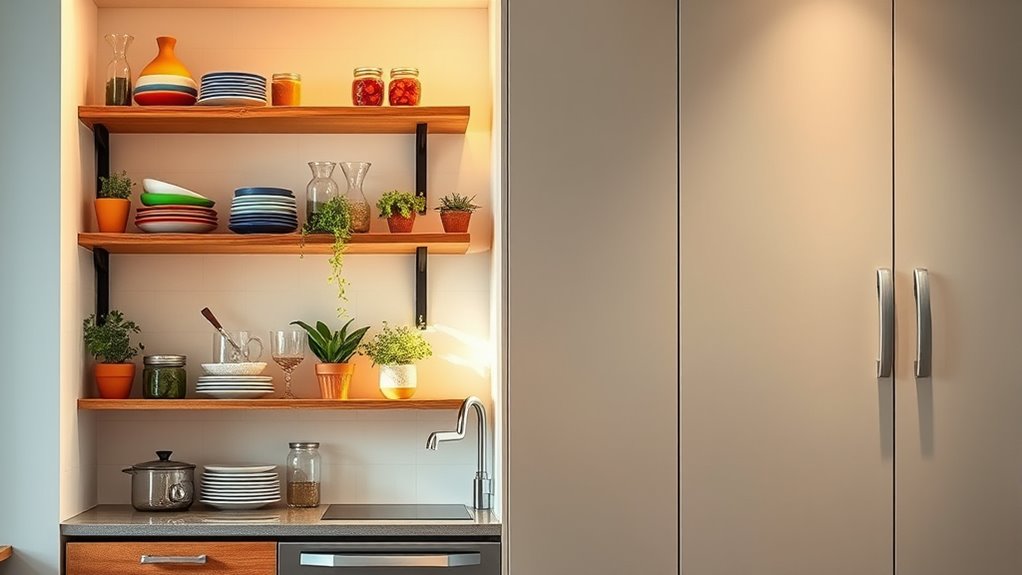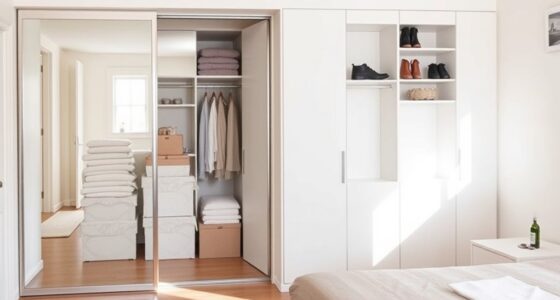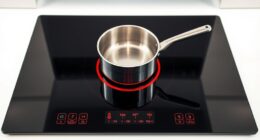In small kitchens, open shelving offers a charming, accessible way to display your dishes and add personality but requires keeping everything neat to avoid clutter. Closed cabinets hide messes and maximize space, giving a clean, streamlined look—perfect for smaller areas. Combining both can provide a balanced solution, offering decorative appeal alongside hidden storage. To discover how to best style and organize your small kitchen using these options, explore the full details ahead.
Key Takeaways
- Open shelving displays personality and decorative items but requires regular organization to prevent clutter in small kitchens.
- Closed cabinets hide clutter, creating a clean, streamlined look ideal for maximizing space efficiency.
- Combining open shelves for essentials and closed cabinets for less attractive items offers balanced functionality and aesthetics.
- Open shelving encourages grouping and attractive storage, while closed cabinets provide hidden storage for tidier spaces.
- Proper organization strategies in closed cabinets and thoughtful shelf arrangement optimize small kitchen storage and visual appeal.

Maximizing storage in small kitchens can feel like a challenge, but with the right choices, you can create a functional and clutter-free space. One of the key decisions you’ll face is whether to choose open shelving or closed cabinets. Each option offers distinct benefits and drawbacks, and your choice will shape the overall look and feel of your kitchen. Think about how you want to use your space and what style best suits your lifestyle.
Open shelving provides an opportunity to showcase your personality through decorative displays. You can easily access everyday items like dishes, glasses, and cookbooks, making your kitchen more practical. When you arrange your dishes and accessories attractively, open shelves become a focal point that adds charm and character. However, they also demand a higher level of cabinet organization, since everything is on display. You’ll need to keep your shelves tidy and free of clutter, or your kitchen may look messy instead of charming. To successfully implement open shelving, consider grouping similar items and using attractive containers or baskets to keep things neat. It’s also wise to balance open shelves with closed cabinets, which can hide less attractive items or supplies you don’t want on show.
Open shelving showcases your style but needs neat organization and balancing with closed cabinets.
Closed cabinets are the classic choice for small kitchens because they hide clutter and keep everything out of sight. They allow you to maintain a clean, streamlined look, which is especially important in tight spaces. With ample cabinet organization, you can maximize every inch of storage and keep your kitchen looking tidy. Use pull-out trays, dividers, and organizers inside your cabinets to make the most of your space. This not only helps you find things more quickly but also prevents clutter from piling up. While closed cabinets don’t give you the opportunity to display decorative items, you can still personalize them with stylish hardware or painted finishes. Plus, they offer a great place to store less attractive or infrequently used items, freeing up your open shelving for decorative displays or everyday essentials. Employing vertical storage solutions can further enhance your cabinet efficiency and help keep your small kitchen organized and clutter-free.
Ultimately, your choice between open shelving and closed cabinets depends on your style preferences and how you want to manage your storage. Combining both can give you the best of both worlds: open shelves for decorative displays and easy access, plus closed cabinets for clutter control and hidden storage. Whichever route you take, focus on smart organization and thoughtful design to make your small kitchen both functional and inviting.
Frequently Asked Questions
How Do Open Shelving and Closed Cabinets Impact Kitchen Hygiene?
Open shelving can make your kitchen less hygienic if you don’t maintain regular cleaning techniques, as dust accumulation on exposed surfaces is common. Closed cabinets help keep dust and grease away, making cleaning easier and more effective. With open shelves, you’ll need to wipe down surfaces often, while closed cabinets require less frequent cleaning. Choose based on your ability to keep each clean and your overall hygiene preferences.
What Are the Cost Differences Between Open Shelving and Closed Cabinets?
Open shelving generally costs less than closed cabinets because of lower material costs and simpler installation. You’ll save on materials since open shelves use fewer components and often require less hardware. Installation expenses are also lower, as they’re easier and quicker to install compared to fully enclosed cabinets. However, keep in mind that choosing durable materials for open shelving might increase costs slightly, but overall, open shelving tends to be more budget-friendly.
Which Storage Option Is More Durable for High-Traffic Kitchens?
You might think closed cabinets are more durable, but open shelving can be just as resilient if made from high-quality materials like solid wood or metal. These materials offer superior scratch resistance and withstand high-traffic use better. Open shelves are easier to repair or replace if damaged, making them a practical choice. Ultimately, choose durable materials for open shelving if you want a sturdy, long-lasting option for busy kitchens.
How Do Open Shelves Affect Natural Light and Room Perception?
Open shelves boost visual openness, making your small kitchen feel more spacious and airy. By allowing natural light to flow freely across the room, they enhance room perception, creating a brighter, more inviting atmosphere. You’ll notice that open shelving minimizes visual clutter and emphasizes the space’s size, giving your kitchen an open, fresh look. This sense of roominess can make even compact kitchens seem larger and more comfortable.
Can Open Shelving Be Safely Used for Heavy or Bulky Items?
Open shelving is like a sturdy tree branch—you can’t hang anything too heavy from it. For heavy or bulky items, check the weight capacity before placing them on open shelves. Always follow safety precautions, like securing shelves properly and avoiding overloads, to prevent accidents. If your items exceed the weight limit, consider closed cabinets or reinforced shelves to keep everything safe and accessible.
Conclusion
Ultimately, choosing between open shelving and closed cabinets depends on your style and needs. Open shelves can make your small kitchen feel more spacious and accessible, but they require regular tidying. Closed cabinets hide clutter and keep things out of sight, creating a neater look. Remember, it’s not just about storage—it’s about making your kitchen work for you. Sometimes, you have to roll with the punches and find what truly fits your space and lifestyle.









